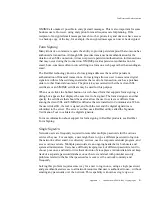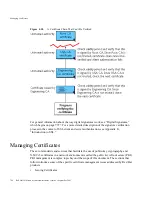
Certificates and Authentication
782
Red Hat Certificate System Administrator’s Guide • September 2005
SSL Protocol
The Secure Sockets Layer (SSL) protocol is a set of rules governing server authentication,
client authentication, and encrypted communication between servers and clients. SSL is
widely used on the Internet, especially for interactions that involve exchanging confidential
information such as credit card numbers.
SSL requires a server SSL certificate, at a minimum. As part of the initial “handshake”
process, the server presents its certificate to the client to authenticate the server’s identity.
The authentication process uses public-key encryption and digital signatures to confirm that
the server is in fact the server it claims to be. Once the server has been authenticated, the
client and server use techniques of symmetric-key encryption, which is very fast, to encrypt
all the information they exchange for the remainder of the session and to detect any
tampering that may have occurred.
Servers may optionally be configured to require client authentication as well as server
authentication. In this case, after server authentication is successfully completed, the client
must also present its certificate to the server to authenticate the client’s identity before the
encrypted SSL session can be established.
For an overview of client authentication over SSL and how it differs from password-based
authentication, see “Authentication Confirms an Identity,” which begins on page 775.
”
For
more detailed information about SSL, see Appendix K, “Introduction to SSL.”
Signed and Encrypted Email
Some email programs (including Messenger, which is part of Communicator) support
digitally signed and encrypted email using a widely accepted protocol known as Secure
Multipurpose Internet Mail Extension (S/MIME). Using S/MIME to sign or encrypt email
messages requires the sender of the message to have an S/MIME certificate.
An email message that includes a digital signature provides some assurance that it was in
fact sent by the person whose name appears in the message header, thus providing
authentication of the sender. If the digital signature cannot be validated by the email
software on the receiving end, the user will be alerted.
The digital signature is unique to the message it accompanies. If the message received
differs in any way from the message that was sent—even by the addition or deletion of a
comma—the digital signature cannot be validated. Therefore, signed email also provides
some assurance that the email has not been tampered with. As discussed at the beginning of
this document, this kind of assurance is known as nonrepudiation. In other words, signed
email makes it very difficult for the sender to deny having sent the message. This is
important for many forms of business communication. (For information about the way
digital signatures work, see “Digital Signatures,” which begins on page 772.
”
)
Содержание CERTIFICATE 7.1 ADMINISTRATOR
Страница 1: ...Administrator s Guide Red Hat Certificate System Version7 1 September 2005 ...
Страница 22: ...22 Red Hat Certificate System Administrator s Guide September 2005 ...
Страница 128: ...Cloning a CA 128 Red Hat Certificate System Administrator s Guide September 2005 ...
Страница 230: ...Configuring Key Archival and Recovery Process 230 Red Hat Certificate System Administrator s Guide September 2005 ...
Страница 234: ...Enterprise Security Client 234 Red Hat Certificate System Administrator s Guide September 2005 ...
Страница 368: ...ACL Reference 368 Red Hat Certificate System Administrator s Guide September 2005 ...
Страница 460: ...Constraints Reference 460 Red Hat Certificate System Administrator s Guide September 2005 ...
Страница 592: ...CRL Extension Reference 592 Red Hat Certificate System Administrator s Guide September 2005 ...
Страница 676: ...Cloning the Data Recovery Manager 676 Red Hat Certificate System Administrator s Guide September 2005 ...
Страница 688: ...Security Requirements for the IT Environment 688 Red Hat Certificate System Administrator s Guide September 2005 ...
Страница 720: ...1 3 Organization Security Policies 720 Red Hat Certificate System Administrator s Guide September 2005 ...






























